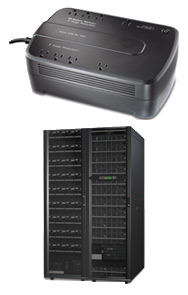Uninterruptible Power Supplies
 In the event of a power failure, Uninterruptible Power Supplies (UPS) provide emergency instantaneous power to critical devices - computers, data centers, and telecommunications equipment - through energy that is typically stored in a battery. UPS temporarily provide this power to allow for proper equipment shut down (e.g., computers) or for a standby power generator to start up (e.g., at data centers). In addition, UPS are able to protect against power surges, voltage drops, and frequency distortions. ENERGY STAR certified UPS can cut energy losses by 30-55%. A 1000 kVA UPS used in a large data center could save $18,000 annually.
In the event of a power failure, Uninterruptible Power Supplies (UPS) provide emergency instantaneous power to critical devices - computers, data centers, and telecommunications equipment - through energy that is typically stored in a battery. UPS temporarily provide this power to allow for proper equipment shut down (e.g., computers) or for a standby power generator to start up (e.g., at data centers). In addition, UPS are able to protect against power surges, voltage drops, and frequency distortions. ENERGY STAR certified UPS can cut energy losses by 30-55%. A 1000 kVA UPS used in a large data center could save $18,000 annually.
ENERGY STAR UPS covers from the small devices beneath your desk protecting your computer to 8-ton versions designed to temporarily provide a megawatt of power to large data centers.
| UPS Topology Typically Referred To As: | Referred To In ENERGY STAR Specification As: | Typically Sized Up To: | Typically Used For: |
|---|---|---|---|
|
Voltage and Frequency Dependent (VFD) | 1,500 VA | small offices, personal home computers and other less critical applications |
|
Voltage Independent (VI) | 5,000 VA | small business, Web, and departmental servers |
|
Voltage and Frequency Independent (VFI) | 1,000 kVA | data centers |
ENERGY STAR certified UPS can also offer multi-mode operation, whereby a more efficient VFD mode is used unless power conditions warrant that a more highly protective VFI mode is needed. Finally, modular UPS, which use changeable small modules (10 to 50 kVA) to adjust for growth as needed, reduce maintenance, and increase efficiency. UPS are more efficient at higher capacity.
See additional information on saving energy in data centers through purchasing efficient UPSs.
Current Specification Effective Date: August 2012
Choosing a UPS
The choice of UPS is a complicated process and depends on a number of factors, including:
- the type of equipment you have;
- the number and size of equipment pieces to be protected (each possibly drawing a different amount of current);
- the features you require (e.g., communication port and smart software); and
- the length of "uptime" in the event of an outage
With many sizes and types of UPSs, a buyer must carefully examine each piece of critical equipment to be protected by the UPS -- taking into account the amount of power your combined equipment will draw and the time that this equipment needs to be supported ? and work in an appropriate safety margin to accommodate growth. Several UPS manufacturers provide online guides for office equipment, server rooms and entire data centers. These guides allow you to enter your equipment types and receive recommendations for UPS sizing and type.
In addition, below are white papers that explore the different types of UPSs for data centers:
- Comparison of Static and Rotary UPSs (PDF, 1.1 MB)
- Comparison of On-Line versus Line Interactive UPSs (PDF, 266 KB)
- What Factors to Consider Specifying a UPS for Your Data Center (PDF 2.5 MB)
Helpful Hints When Purchasing a UPS for Your Computer
- Make sure that the UPS comes with software which shuts down and backs up computers.
- Make sure that the UPS includes surge protectors on input and communication lines.
- Consider an air conditioned location --battery lifetime is strongly temperature dependent and decreases by 50 percent with every 15 degrees in temperature rise.
- Make sure that the UPS performs automatic battery tests to warn whenever the batteries should be replaced.
- Consider selecting the next higher UPS size to increase backup time.












